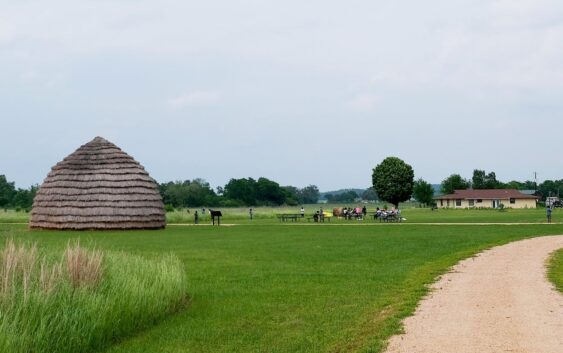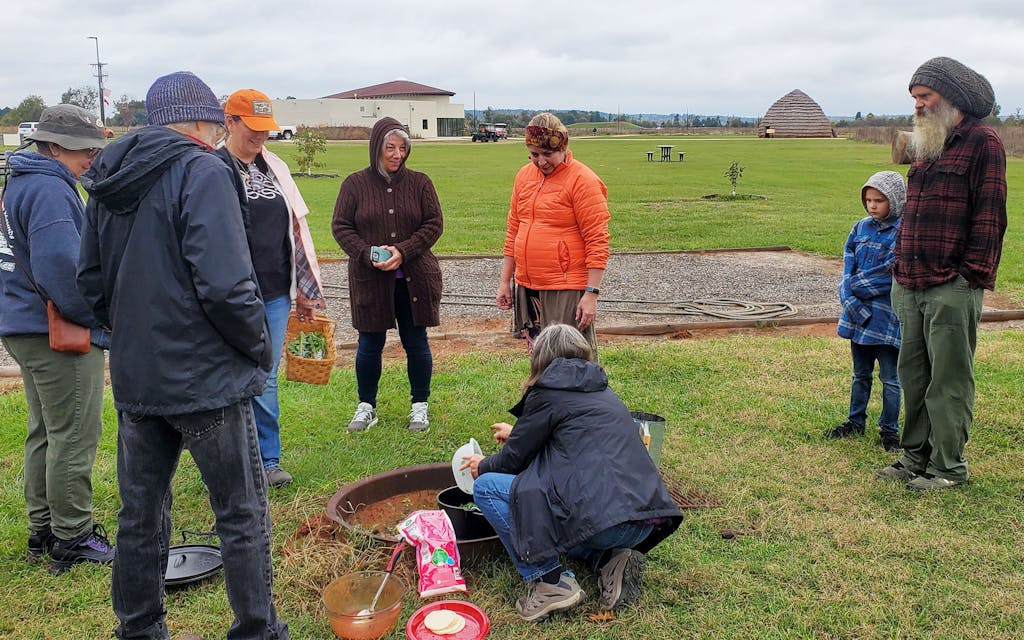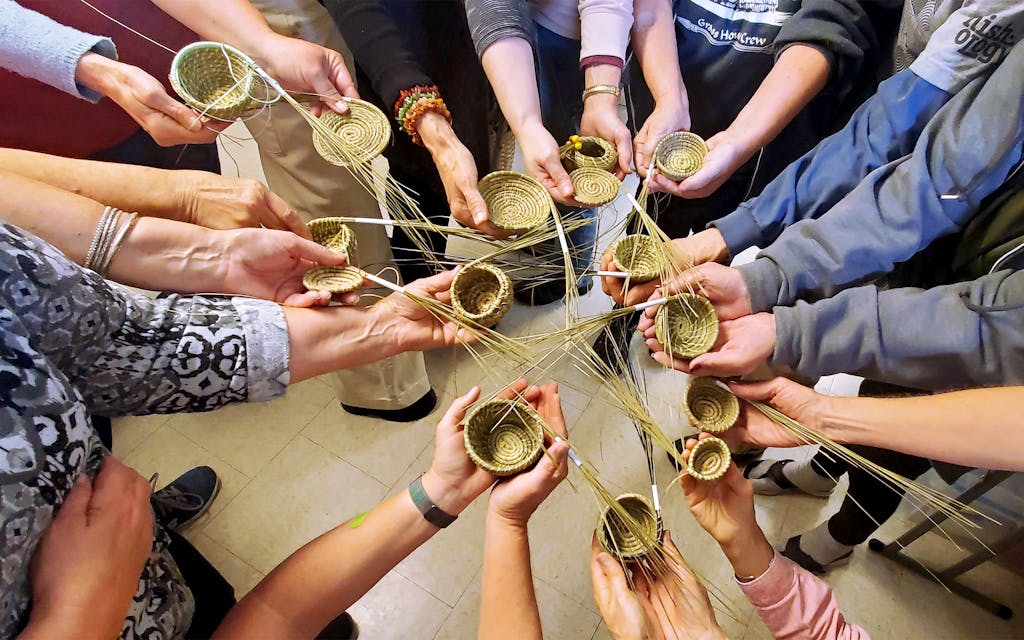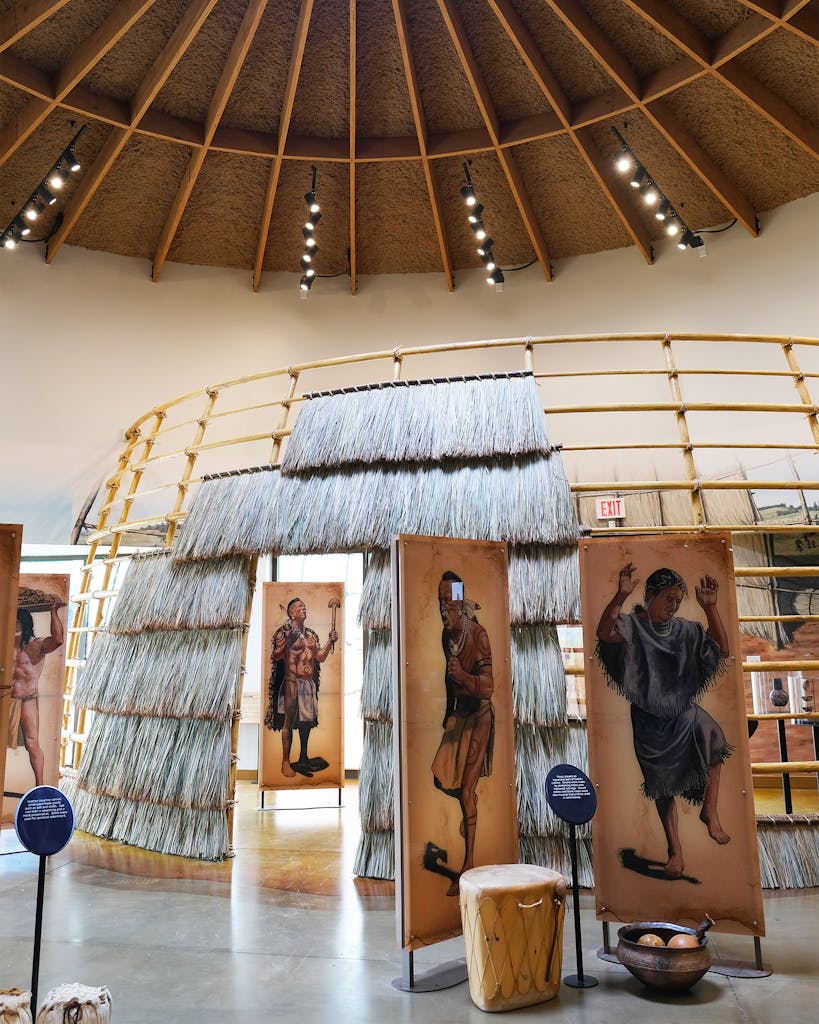- They couldn’t save their daughters’ lives in the July 4 floods. Now they’re dealing with the grief and the guilt.
- Austin could see heavy rains, possible flooding over the next few days
- Families of campers, counselors who died in Texas Hill County floods sue Camp Mystic
- Small plane bound for Jamaica with hurricane relief supplies crashes in Florida neighborhood
- Ask the Meteorologist: Did a tornado hit Johnston County Saturday night?
Five Years After a Devastating Tornado, Caddo Mounds Reopens With a New Mission

Five Years After a Devastating Tornado, Caddo Mounds Reopens With a New Mission
Caddo artists and teachers are reclaiming this sacred place in East Texas.
Cynthia J. Drake
On April 13, 2019, a tornado touched down directly on Caddo Mounds State Historic Site, in Alto, about thirty miles west of Nacogdoches. The storm chewed up cars, trees, and most of the modern, human-made structures on the site. The titular mounds—three large, sloping ceremonial earthworks at least a thousand years old—were unscathed, but the human toll was another story. One passerby died, one survivor became paraplegic, and several others were seriously injured. After the tornado came, everything changed. To some, it seemed like nature had demanded it.
That day in 2019 had been the annual planned observance of Caddo Culture Day, when dozens of Caddo members traveled from Arkansas, Louisiana, and Oklahoma to East Texas to celebrate with traditional song and dance on the sacred ancestral ground along with visitors from surrounding communities. Instead of celebrating that day, though, attendees sheltered from the pummeling storm inside the visitors center, whose walls would later collapse in on them, leaving forty people injured, including several in critical condition, while they waited three hours for help to arrive.
Five years later, as the site’s visitors center officially reopened on May 18 following a $2.5 million restoration, staff, volunteers, and Caddo visitors at the site say they’re feeling a complex mixture of grief, hope, and reckoning. This state-owned historic site had already long been a complicated symbol for Indigenous people. Some Caddo people feel that they have been called to reclaim the site; about six teachers plan to return to share lessons this year on traditional and modern arts such as basketry and pottery. At the same time, some of the six Texas Historical Commission employees here have tried to mine their own meaning from the natural disaster, taking the experience as a call to reframe the mission of Caddo Mounds.
Most people who come to Caddo Mounds recognize the three large earthen, grass-covered hills that rise out of the landscape, each sealed up and containing evidence of an ancient civilization that once thrived here, starting in the ninth century. Two of the mounds are thought to contain ceremonial objects, and one is a burial mound. The Caddo abandoned this particular dwelling site for unknown reasons, capping the mounds with layers of clay around the year 1300, but continued to live in the region. For many modern-day Caddo people, this is a sacred ground—one that they would not typically return to, and certainly would not consider appropriate to open to the public as a tourist site.
“I had never heard of Caddo Mounds for a long time,” says Chase Kahwinhut Earles, an artist and member of the Caddo Nation who lives in Ada, Oklahoma, and has taught traditional pottery classes at Caddo Mounds State Historic Site over the past decade. He says that since his community has officially been established in Binger, Oklahoma, for generations (other bands of Caddos were dispersed to other states), there wasn’t much discussion or awareness about the ancient site about six hours to the south. Following the tornado, when Caddo members from across the country came to help rebuild a traditional grass house there, that connection deepened.
Earles, 48, says his first visit to Caddo Mounds, in his thirties, evoked feelings of reverence. “It was definitely an experience being in one of the more complete Caddo ancient village sites,” he says. “Most of the other Caddo village sites are gone—bulldozed over, or roads or crops or properties have flattened them. But I was also anxious, because you know your ancient ancestors are buried there, and so it’s a very sacred site. And that’s kind of hard to reconcile with the fact that it’s a public visiting site. But as natives do, we kind of live in both worlds; we compartmentalize.”

If you wander past the mounds via the rutted path that forms part of the old El Camino Real de los Tejas, an eighteenth-century Spanish trail that is a reminder of the colonial forces that eradicated many Indigenous groups from Texas, you can find your way into a forested patch on the historic site’s four hundred acres. Past crimson clover and sweet-smelling grasses, there’s a thick patch of river cane, a culturally significant plant that was historically used in Caddo basketmaking. Now it’s being propagated again and harvested for basketry classes.
Nearby is a small pond (where a resident alligator named Snappy lives), and beyond that is Bowles Creek, a tributary of the Neches River. On these riverbanks, Earles and a group of students have come to collect clay for a four-week traditional pottery workshop currently underway. Earles has found that the clay here is perfect for making pottery. Unlike clay harvested from other riverbanks, which usually must be coaxed into the right texture with the addition of mussel shells or crushed pottery shards, it emerges from the riverbanks ready to process and mold by hand.
Earles is carrying on a tradition that was nearly lost. The techniques for making Caddo pottery, which is known for its burnished dark exteriors and intricate etchings in the ceremonial pots, almost died out in the early 1900s. Earles, whose work is displayed in museums around the country, developed his methods by learning from artists and elders, as well as listening to audio recordings in a University of Oklahoma archive. He also meticulously researched archaeological records in Arkansas, Louisiana, Oklahoma, and Texas to find examples of the same pottery he makes.
Earles had to reconcile his mission to learn with the fact that traditionally, Caddo people would not touch or go near ceremonial pottery, much like with the ancient sites. But passing on the traditional methods would help keep the art alive, he reasoned. “It’s about educating everyone, even the Caddos, about our ancient history and our legacy and our cultural identity,” he says.

Earles, along with other Caddo members like Jackie Bullard, who is leading a basketry revival project using river cane, and screen printing artist Kacey Roach, is among some of the artists teaching as part of a Caddo Artist Series sponsored by the Texas Historical Commission, now running at Caddo Mounds every other month through November. Caddo Mounds staff members, who are non-Indigenous, have worked to develop relationships and build trust with Caddo members over the past decade and find opportunities to be costewards of the site. The experience of the tornado only underscored that resolve for Rachel Galan, assistant site manager. She has recruited more Native teachers and tried to reach more prospective Native students to join the classes.
“When I first got here [in 2014], I was like, ‘How do I interpret Caddo culture and history, not being Caddo?’ And I grappled with that a lot, and I worked really hard at how to do that,” says Galan, who focused her educational programming around universal concepts like storytelling to help bridge gaps between Indigenous and non-Indigenous visitors. “It’s ironic now, because I would never even presume to do that. That all changed for me with the tornado. Being claimed by space was what it felt like. It changed my relationship with the Caddo people I was working with. It created family and community in a different way.” She remembers the way community members tended to one another in the hours after the traumatic event, during which Galan was pinned in and her husband, archaeologist Victor Galan, sustained life-threatening injuries to his spinal cord. After surviving that, she says, her commitment to Caddo Mounds only deepened: “I didn’t have a choice.”
In the years since the tornado, Galan’s focus has been to explore even more ways to embrace a “braided” approach to land conservation and education at the site. This approach, which is informed by Robin Wall Kimmerer‘s book Braiding Sweetgrass, incorporates not just Western-minded ways but also traditional Indigenous ecological knowledge. It’s only in its infancy at Caddo Mounds, but it involves an approach that takes into consideration ideas like reciprocity and responsibility to future generations. Two early projects include the river cane propagation and planting gourds for artist Tracy Newkumet-Burrows’s functional gourd bowls.
On the other hand, staff members ended up turning down a $40,000 donation from a nonprofit organization for longleaf pine forest restoration. The offer came in just as they’d started serious discussions about the braided approach. Doing the project would have required adherence to a Texas A&M Forest Service ten-year plan to remove all vegetation from twenty acres of land, first spraying the ground with an herbicide to kill off all existing vegetation before planting trees. Galan asked for a year to work on a braided approach instead, but the offer was quickly rescinded by the donor, who didn’t understand why Galan hadn’t immediately jumped at the opportunity. Galan says it’s necessary to embrace a new mindset if Caddo Mounds State Historic Site is to deepen its partnership with the Caddo community in a meaningful way.
Something else that’s new since the tornado: for the first time, three of the six board members of Friends of Caddo Mounds, the nonprofit that helps advise and support the site, are Caddo members. The group hopes to eventually raise funds to build a new education center, which will continue the work of reviving traditional arts and showcasing modern Caddo artists and teachers.

With this lens, the new visitors center becomes a bit of a contradiction. Most of the exhibits are roughly the same ones that existed prior to the building’s destruction by the tornado, with displays on the Caddo creation story, traditional agriculture, trade, and more. There’s also a small gift shop, plus some materials for self-guided tours. But the real vitality of the site exists in the arts programming and in the outdoor spaces. Galan often guides visitors on foraging walks, introducing them to edible plants like chickweed, wood sorrel, and broadleaf plantain. Broadleaf plantain was one of the first plants introduced to North America by Europeans, and Indigenous people sometimes call it white man’s footprint. It’s considered a healing plant—you can chew it and make poultices for bites, or use longer leaves as bandages, and Kimmerer identified it in Braiding Sweetgrass as a hopeful metaphor for braided land conservation. Galan says children, in particular, love it when she gives them permission to make their own spit poultices or taste the sour notes of wood sorrel for the first time. You don’t feel that same sense of discovery and joyful energy inside a building focused on interpreting Caddo culture to outsiders.
Bullard, the basket maker who also serves as board president of the Friends group, says the gaze of the visitor has long been somewhat problematic for her people. “At some point, if you have Native blood, you’re tokenized, you’re just another exhibit,” she says. Bullard, who now lives in Shreveport, Louisiana, remembers attending past Caddo Culture Days, starting about twenty years ago, and not always feeling at ease. “Sometimes when we’re invited places, it’s, ‘Okay, but you’ve got to sing for your supper.’ . . . That’s not always the easiest stuff to say.”
“I think people don’t realize how extractive it can be. Because our histories are rich and there’s so much knowledge there, and people are curious. But sometimes it can feel very much an invasion of privacy,” she says. “And to me [a visitors center] is just not a priority. What is is action and being able to share our knowledge base. Protection of the landscape and restoring the prairies, and to be able to teach those things to our children and to visitors.”
Though Bullard says there’s always sadness and heartache inherent in sacred sites that are owned by the state, she has sensed a shift in recent years. “I just think it has opened up a different dialogue—to be represented, and not just on display,” she says. “I definitely feel that my ancestors are there, and I actually am feeling very called back. Starting with teaching and having a place where I can share. I know that river cane is going to be protected. And conservation is a big deal—we take care of our plants and animals and wildlife differently. It’s not about spraying and planting all the things, it’s about full cycles of intentions—what are companion plants, what’s going to support each other, what’s going to heal the soil.”
- More About:
- Texas History
- East Texas